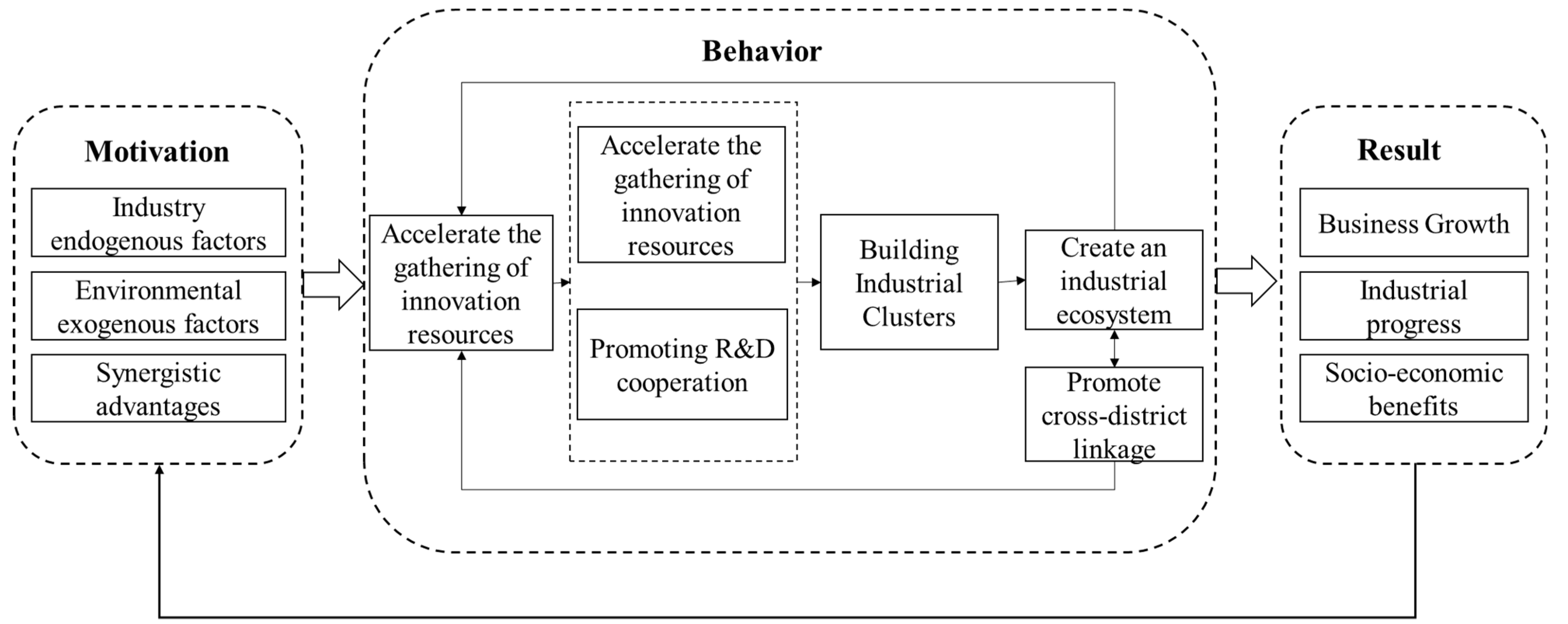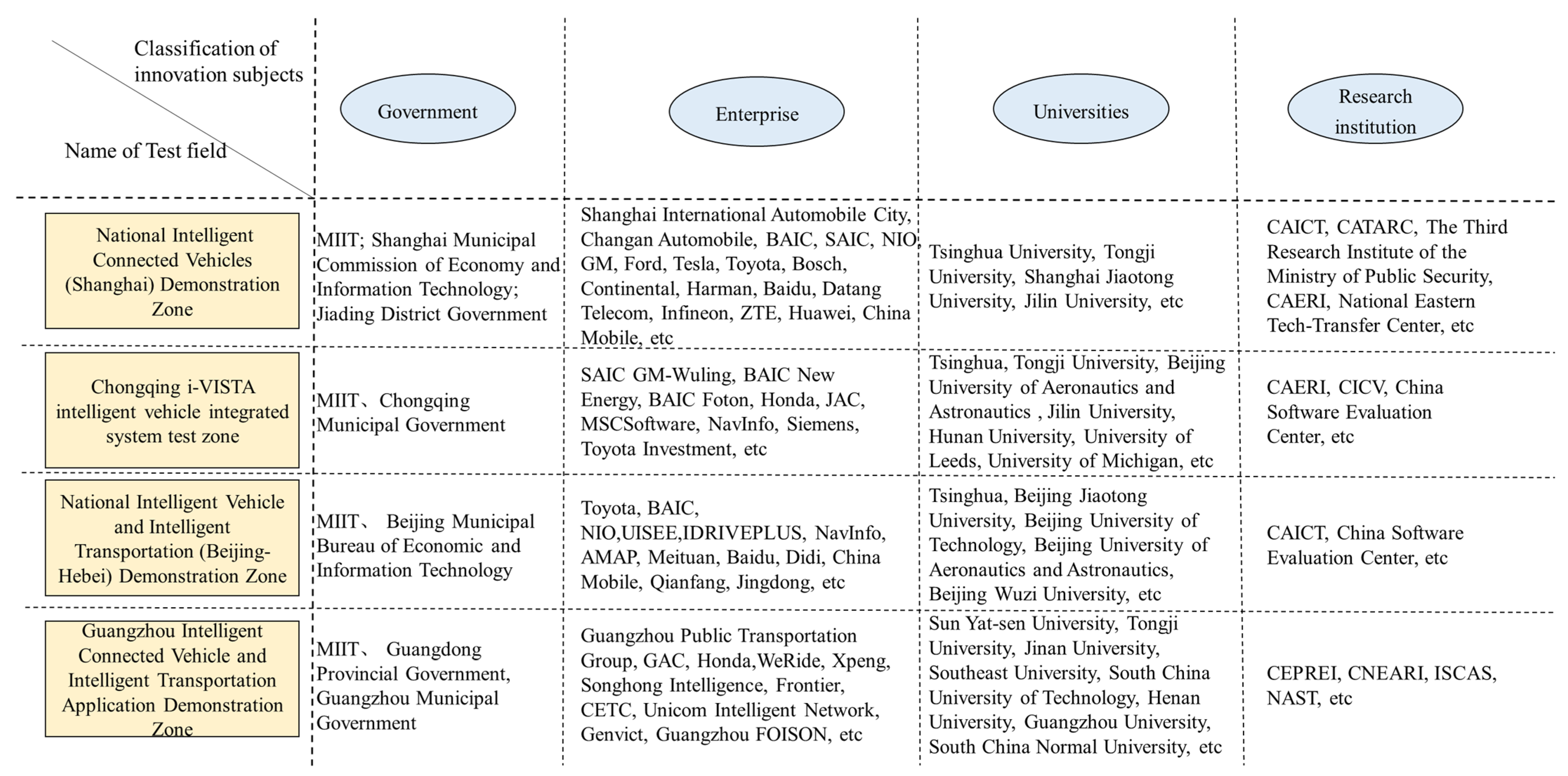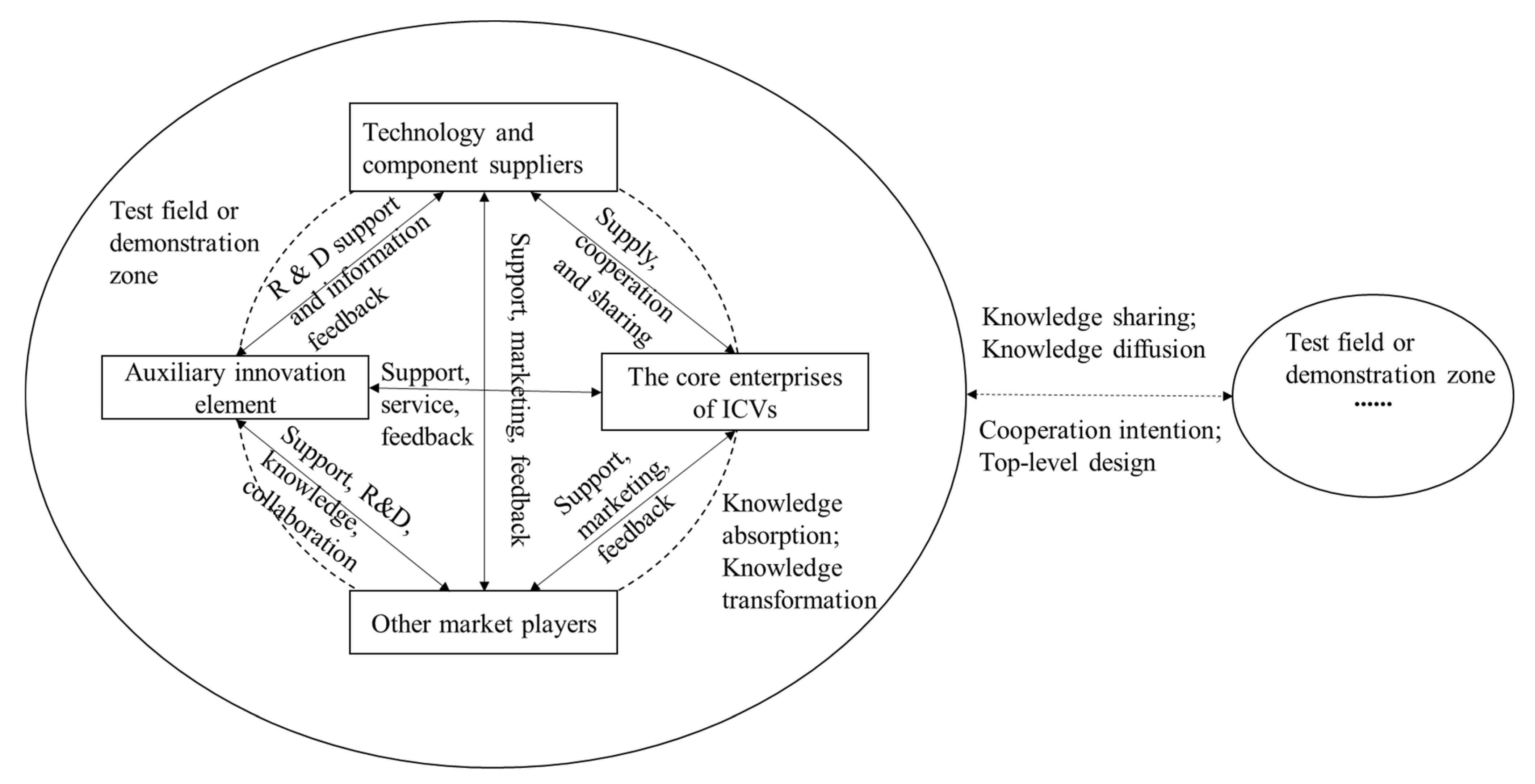Research on Collaborative Innovation of Intelligent Connected Vehicles Industry Based on Test Field: Embedded Case Study from the Perspective of Open Innovation
Abstract
:1. Introduction
2. Literature Review and Theoretical Basis
3. Research Design and Case Study Analysis
3.1. Research Design
3.1.1. Research Methodology
3.1.2. Case Selection
3.1.3. Data Collection
3.2. Data Processing and Case Analysis
3.2.1. Open Coding
3.2.2. Spindle Type Coding
3.2.3. Selective Coding
4. Collaborative Innovation Mechanism and Path of ICV Industry
4.1. Industrial Collaborative Innovation Path Led by Core Enterprises in the Test Field
4.2. Industrial Collaborative Innovation Path Led by the Test Field
5. Conclusions and Recommendations
- Play the guiding role of the government, accelerate the pace of policy innovation, and support the collaborative development of the industry from the perspective of a top-level design. First, accelerate the pace of revision of relevant management systems and laws and regulations, especially the standardization and improvement of the management system of self-driving road tests and the right-of-way of autonomous vehicles, business permits, and accident attribution. This is the institutional prerequisite for the large-scale market promotion of autonomous vehicles. Second, promote the establishment of a collaborative innovation platform for the ICV industry based on the test field. Promote the gathering of innovation resources in the test field through strategic planning, financial and tax incentives, as well as other innovative policies, so as to provide convenience and preferential conditions for the stakeholders of the ICV industry chain in the test field. Third, the government takes the lead in building bridges for cross-region linkage among test field. Open up channels for cross-region cooperation from the perspective of top-level design, accelerate test data sharing, the mutual recognition of test results, knowledge and resource sharing, etc., pay more attention to removing barriers to cooperation [44], and promote the establishment of trust relationships among the test field.
- Support the establishment of industrial innovation alliances using the test field and demonstration zones as platforms. China’s ICV test field gathers multiple types of innovation subjects, such as government, universities and research institutions, and enterprises, because they are usually built in conjunction with application demonstration zones. Accordingly, make full use of this condition to establish an ICV industry innovation alliance. On the one hand, it builds a platform for collaborative innovation among subjects in the test field, breaks down communication barriers, smooths communication channels, and reduces the cost of collaborative innovation. On the other hand, it promotes the construction of industrial clusters in the test field, creates a regional ICV industrial ecosystem, improves the industrial development environment, and enhances the industrial adsorption capacity of the test field and its region, thus further accelerating the gathering of innovation resources and forming a virtuous cycle.
- Promote the diversification of innovation subjects and resources in the test field and play the role of intermediary institutions, such as finance. At present, the innovation subjects in the test field are mainly government, enterprises, universities, and research institutions, while intermediaries, such as financial investment institutions, are relatively few or lacking. Financial investment institutions are an important resource in assisting innovation, and they are particularly important in the development of innovation in the ICV industry because of the large amount of capital investment that is required for the construction and operation of the test field, the preliminary R&D, and production of ICV. Take the initiative to introduce banks, venture capital, insurance, and other financial investment institutions into the test field, or join the industrial alliance that formed with the test field as a platform to provide sufficient financial support for the technological innovation and industrialization of ICV in the test field, and provide a financial flow for the collaborative innovation of all subjects.
- Relying on the test field to accelerate the pace of technological innovation and industrialization of the results of ICV. Give full play to the technical advantages of the innovation subjects in the test field, build a R&D cooperation platform that relies on the test field, and promote scientific research cooperation among subjects. Focus on key technologies in the fields of perception system, communication system, decision-making system, and control execution system. Break through the bottlenecks of ICV technologies and components, such as sensors and chips, and improve the technical innovation capacity, independent R&D, and manufacturing capacity of enterprises that are related to ICV in China. At the same time, supporting the construction of the whole industry chain, integration construction, and the construction of the cooperation system between government, industry, academia, research, and application to create an ICV ecosystem. Finally, providing the necessary guarantee for the transformation of the technological achievements of ICV, and providing the testing and application scenarios for demonstration operations nearby in order to accelerate the pace of industrialization and commercialization.
Author Contributions
Funding
Data Availability Statement
Acknowledgments
Conflicts of Interest
References
- Wei, Y.; Huixiong, X. Huawei Enters the Game to Build the Main Engine of Automotive Intelligence; Essence Securities: Shenzhen, China, 2020. [Google Scholar]
- Chuxiong, F.; Kai, W. Autonomous Driving is Approaching, and the In-Vehicle Sensor Market is Welcoming Rapid Development; China Galaxy Securities Research Institute: Beijing, China, 2021. [Google Scholar]
- China Intelligent Networked Vehicle Industry Innovation Alliance Group. Report on China’s Smart Internet-Connected Passenger Vehicle Sales; China Intelligent Networked Vehicle Industry Innovation Alliance: Beijing, China, 2020. [Google Scholar]
- Bing, Z.; Peixing, Z.; Jian, Z.; Hong, C.; Zhigang, X.; Xiangmo, Z.; Weiwen, D. Research progress of scenario-based virtual testing of self-driving vehicles. Chin. J. Highw. 2019, 32, 1–19. [Google Scholar]
- Lai, J.K. Patent posture analysis of intelligent decision-making technologies for Intelligent Connected Vehicless. Chin. Invent. Pat. 2018, 15, 114–118. [Google Scholar]
- Chunlin, F. Development dilemmas and coping strategies of China’s Intelligent Connected Vehicles industry. Contemp. Econ. Manag. 2018, 40, 64–70. [Google Scholar]
- Chesbrough, H. Open platform innovation: Creating value from internal and external innovation. Intel Technol. J. 2003, 7, 5–9. [Google Scholar]
- Lichtenthaler, U. Open Innovation: Past Research, Current Debates, and Future Directions. Acad. Manag. Perspect. 2011, 25, 75–93. [Google Scholar]
- Lyu, Y.; Zhu, Y.; Han, S.; He, B.; Bao, L. Open innovation and innovation Radicalness-the moderating effect of network embeddedness. Technol. Soc. 2020, 62, 101292. [Google Scholar] [CrossRef]
- Liangmou, G.; Wenjia, M. Open innovation: Connotation, framework and Chinese context. Manag. World 2014, 157–169. [Google Scholar] [CrossRef]
- Pustovrh, A.; Rangus, K.; Drnovek, M. The role of open innovation in developing an entrepreneurial support ecosystem. Technol. Forecast. Soc. Chang. 2020, 152, 119892. [Google Scholar] [CrossRef]
- Zhaoru, L. A Study on the Impact of Open Innovation and Dynamic Capabilities on the Growth of Cross-Border Firms. Master’s Thesis, Huaqiao University, Xiamen, China, 2019. [Google Scholar]
- Yingying, F.; Jianjiao, L. Creating an ecosystem for China’s chip industry from open collaborative innovation. Ind. Econ. Rev. 2018, 9, 104–115. [Google Scholar]
- Wang, W.-H.; Zhang, Z.; Cai, R.-L. A study on the synergy effect of collaboration management among open innovation organizations affecting knowledge. Res. Dev. Manag. 2018, 30, 38–48. [Google Scholar]
- Ziguang, R.; Pengbin, G. A study on the relationship between two-way open innovation and its synergy, business model and firm innovation performance. Manag. Rev. 2020, 32, 116–130. [Google Scholar]
- Zeyang, L. Research on the Mechanism and Path of Inter-Firm Collaboration in Open Innovation. Master’s Thesis, Hebei University of Technology, Tianjin, China, 2017. [Google Scholar]
- Yanting, G.; Gang, Z.; Zhongwen, Q. A preliminary investigation on the new catch-up path and model of enterprises based on cross-border collaboration under the perspective of open innovation. Sci. Res. Manag. 2019, 40, 169–183. [Google Scholar]
- Laursen, K.; Salter, A. Open for innovation: The role of openness in explaining innovation performance among U.K. manufacturing firms. Strateg. Manag. J. 2006, 27, 131–150. [Google Scholar] [CrossRef]
- Knudsen, M.P.; Mortensen, T.B. Some immediate—But negative—Effects of openness on product development performance. Technovation 2011, 31, 54–64. [Google Scholar] [CrossRef]
- Graciela, C.D.; Jones, J.; Statsenko, L. Managing Innovation Networks for Knowledge Mobility and Appropriability: A Complexity Perspective. Entrep. Res. J. 2016, 6, 75–109. [Google Scholar]
- Lei, S. Research on the Mechanism of Enterprise Innovation Dynamics in Open Innovation Environment. Master’s Thesis, University of Science and Technology of China, Hefei, China, 2019. [Google Scholar]
- Chen-Ning, J.; Hong, Z. Open innovation in Chinese firms: Institutional environment, “competition” relationship and innovation performance. Manag. World 2020, 36, 139–160. [Google Scholar]
- Yu-Fen, C.; Jin, C. A study on the mechanism of open innovation for innovation performance. Res. Manag. 2009, 30, 1–9, 28. [Google Scholar]
- Yuanyuan, Y. Research on the Operation Mechanism of Open Innovation Ecosystem Based on Research Consortium. Master’s Thesis, Jinan University, Jinan China, 2019. [Google Scholar]
- Xie, X.; Wang, H. How can open innovation ecosystem modes push product innovation forward? An fsQCA analysis. J. Bus. Res. 2020, 108, 29–41. [Google Scholar] [CrossRef]
- Zhuo-Ping, Y.; Xing-Yu, X.; Jun-Yi, C. Advances in testing technologies and applications of self-driving vehicles. J. Tongji Univ. 2019, 47, 540–547. [Google Scholar]
- Hong, S.; Kang, Y.; Hailin, X.; Qin, X.; Shan, H. Research on the construction of basic test scenarios for self-driving vehicles. Chin. J. Highw. 2019, 32, 245–254. [Google Scholar]
- Shijia, Z.; Nan, X.; Quansi, C. Characteristics and insights of California’s Autonomous Vehicles road test management. Sci. Technol. Manag. Res. 2020, 40, 220–225. [Google Scholar]
- Huang, L. Research on Field Testing and Evaluation of Partially Self-Driving Vehicles. Master’s Thesis, Chongqing University, Chongqing, China, 2018. [Google Scholar]
- Jun, L. How Institutional Innovation Confronts Automated Driving-Observations and Reflections Based on the Road Testing System. China Sci. Technol. Forum 2019, 44–51. [Google Scholar] [CrossRef]
- Jixia, W.; Daqing, F. Legal regulation of road testing of Autonomous Vehicles. Adm. Reform 2019, 37–43. [Google Scholar] [CrossRef]
- Lee, D.; Hess, D.J. Regulations for on-road testing of connected and automated vehicles: Assessing the potential for global safety harmonization. Transp. Res. Part A Policy Pract. 2020, 136, 85–98. [Google Scholar] [CrossRef]
- Di, Y. Research on Administrative Regulations for Road Testing of Self-Driving Vehicles. Master’s Thesis, Southeast University, Nanjing, China, 2019. [Google Scholar]
- Ting, Z. Research on the Administrative License of Intelligent Connected Vehicles Road Testing. Master’s Thesis, People’s Public Security University of China, Beijing, China, 2020. [Google Scholar]
- Xiaoshuai, Z. Development of a Virtual Test Platform for Autonomous Driving Based on Human-Vehicle-Environment Modeling. Master’s Thesis, Chongqing University of Technology, Chongqing, China, 2019. [Google Scholar]
- Rongjie, Y.; Ye, T.; Jian, S. Virtual testing of high-grade autonomous vehicles: Research progress and frontiers. Chin. J. Highw. 2020, 33, 125–138. [Google Scholar]
- Liu, P.; Xu, Z.; Zhao, X. Road tests of self-driving vehicles: Affective and cognitive pathways in acceptance formation. Transp. Res. Part A Policy Pract. 2019, 124, 354–369. [Google Scholar] [CrossRef]
- Zejin, G. Observation and Research on Baidu Apollo Intelligent Driving Open Platform from the Perspective of Innovation Diffusion. China Sci. Technol. Forum. 2020, 147–152. [Google Scholar] [CrossRef]
- Yin, R.; Thousand, S. Case Study Research: Design and Methods, 4th ed.; Blackwell Science Ltd.: Hoboken, NJ, USA, 2009. [Google Scholar]
- Eisenhardt, K.M. Building theories from case study research. Acad. Manag. Rev. 1989, 14, 532–550. [Google Scholar] [CrossRef]
- Zongyuan, L.; Wenping, L. A study on the dynamic cooperation evolution between platform enterprises and partners based on social capital theory--a longitudinal case study of Cainiao Network. Bus. Econ. Manag. 2020, 15–27. [Google Scholar] [CrossRef]
- Tao, M.; Yuqiao, G.; Zheng, D.; Wei, W. Research on the mechanism of user value ingenuity in sharing economy platforms--A case study of Airbnb and Idlefish. Sci. Technol. Manag. 2020, 41, 111–130. [Google Scholar]
- Yue, L.; Hang, G.; Hongqi, W.; Zhuo, W. The incentive elements and role mechanism of alliance collaborative innovation based on rooting theory. China Sci. Technol. Forum 2020, 129–137. [Google Scholar] [CrossRef]
- Robaczewska, J.; Vanhaverbeke, W.; Lorenz, A. Applying open innovation strategies in the context of a regional innovation ecosystem: The case of Janssen Pharmaceuticals—ScienceDirect. Glob. Transit. 2019, 1, 120–131. [Google Scholar] [CrossRef]





| Test Field/Demonstration Zone | First-Hand Information | Second-Hand Information |
|---|---|---|
| National Intelligent Vehicle and Intelligent Transportation (Beijing-Hebei) Demonstration Zone Yizhuang Base and Haidian Base | Three semi-structured interviews (approximately 35,000 words). Field observation records (approximately 0.7 million words). | Various media coverage (approximately 110,000 words). Relevant policy documents of Beijing and the park (6 copies, about 70,000 words). Reports related to the ICV industry and road testing in Beijing (4 copies, about 65,000 words). |
| Shunyi ICV Innovation Ecological Demonstration Zone | Two semi-structured interviews (approximately 27,000 words). Field observation records (approximately 0.5 million words). | |
| Beijing ICV Demonstration Operation Area (Shougang Park) | 3 semi-structured interviews (32,000 words). Field observation records (approximately 0.5 million words). | |
| Fangshan 5G Autonomous Driving Demonstration Zone | Field observation records (approximately 0.6 million words). |
| Typical Information | Open Coding | |
|---|---|---|
| Conceptualization | Categorization | |
| ICV have the characteristics of great intersection of disciplines and great integration of multiple industries (a1) …… Integration and innovation and open cooperation are the characteristics of the times for the development of ICV (a3).…… | A1 Interdisciplinary …… A3 Industrial characteristics of The Times | AA1 Characteristics of industrial development |
| …… | …… | …… |
| To achieve faster scenario landing for autonomous driving, it also needs more ecological power, especially the participation of Internet technology companies (a18). | A18 Scene landing | AA7 Drives scenarios to the ground |
| Actively unblocking the channel for the docking of innovation resources and the implementation of achievements projects in the “Three Cities” (A19) ...... We will hold regular seminars and forums on autonomous driving-related applications (a22). | A19, A20 Open communication channels A21, A22 break the communication barrier | AA8 Break barriers and open channels |
| …… | …… | …… |
| Establish and improve the linkage development mechanism of the three regions, accelerate the integrated development of Taihu and Majuqiao areas and the core area of the development zone (a105) …… Accelerate the market connection and project cooperation with key regions in Beijing-Tianjin-Hebei, and build a cross-regional, multi-echelon industrial development layout with enterprises as the main body…… (a111). | A105, A106 Joint development of the park …… A109, A110, A111 Collaborate layout across regions | AA24 Cross-district linkage |
| ……For Audi its a favourable position, will greatly accelerate the progress of the enterprise’s R&D innovation (a112) …… The development of the domestic ICV industry is still facing numerous key technical bottlenecks. The cooperation among various subjects realizes complementary advantages and speeds up the breakthrough of technical bottlenecks. (a113) | A112 Accelerate enterprise R&D innovation A113 Key technology breakthrough and upgrade | AA25 Improving the technological competitiveness of enterprises |
| …… | …… | …… |
| ……It seems that the adsorption effect of the Smart Town demonstration project has already appeared, and more and more innovative enterprises and projects are gathering here (a127). | A127 Adsorption effect | AA32 Enhances the adsorption effect |
| Core Scope | Main Category | Sub-Categories |
|---|---|---|
| Motivation | Industry endogenous factors | Characteristics of industrial development; industrial development needs; willingness to cooperate |
| Environmental exogenous factors | Top-level support; resource base | |
| Synergistic advantages | Have the advantage of platform; drive the scene to land | |
| Behavior | Accelerate the gathering of innovation resources | Break down barriers and open channels; supporting environmental construction; attracting investment |
| Build an innovative cooperation platform | Establish industry alliances; create platforms | |
| Promoting R&D cooperation | Joint construction of research platform; joint technological research; technology integration | |
| Building Industrial Clusters | Attracting enterprises to move in; promoting industrial clustering; promoting industrial integration | |
| Create an industrial ecosystem | Develop the whole industry chain; Integration of test and demonstration application; promote coordination between human, vehicle, road, cloud, network and city; promote cooperation between government, industry, academia, research and use | |
| Promote cross-district linkage | Cross-district linkage | |
| Result | Business growth | Improve enterprise technology competitiveness; accelerate commercial operation |
| Industrial progress | Data sharing and value-added; promoting industrialization; promoting industrial technology standardization | |
| Socio-economic benefits | Promote regional economic growth; improve traffic efficiency and safety; enhance the adsorption effect |
Publisher’s Note: MDPI stays neutral with regard to jurisdictional claims in published maps and institutional affiliations. |
© 2021 by the authors. Licensee MDPI, Basel, Switzerland. This article is an open access article distributed under the terms and conditions of the Creative Commons Attribution (CC BY) license (https://creativecommons.org/licenses/by/4.0/).
Share and Cite
Zhou, F.; Liu, Y.; Chen, R. Research on Collaborative Innovation of Intelligent Connected Vehicles Industry Based on Test Field: Embedded Case Study from the Perspective of Open Innovation. Sustainability 2021, 13, 5880. https://doi.org/10.3390/su13115880
Zhou F, Liu Y, Chen R. Research on Collaborative Innovation of Intelligent Connected Vehicles Industry Based on Test Field: Embedded Case Study from the Perspective of Open Innovation. Sustainability. 2021; 13(11):5880. https://doi.org/10.3390/su13115880
Chicago/Turabian StyleZhou, Fei, Yingqi Liu, and Ruijun Chen. 2021. "Research on Collaborative Innovation of Intelligent Connected Vehicles Industry Based on Test Field: Embedded Case Study from the Perspective of Open Innovation" Sustainability 13, no. 11: 5880. https://doi.org/10.3390/su13115880
APA StyleZhou, F., Liu, Y., & Chen, R. (2021). Research on Collaborative Innovation of Intelligent Connected Vehicles Industry Based on Test Field: Embedded Case Study from the Perspective of Open Innovation. Sustainability, 13(11), 5880. https://doi.org/10.3390/su13115880






